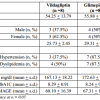
About Odessa Wilson, MD, FPCP
I specialize in adult diseases, diabetes, thyroid problems, diseases of the pituitary gland, adrenal glands and other hormones as well as bone-related diseases such as osteoporosis and vitamin D deficiency.
Thyrotoxicosis or hyperthyroidism is relatively rare in children. According to reports, the yearly incidence is 8 per 1 million children who are younger than 15 years old and 1 per 1 million in children younger than 4 years old. Among these patients, Graves’ Disease is the most common cause. It is noted that girls are affected five times more than boys. A family history of hyperthyroidism should be sought because many have a positive family history of autoimmune thyroid diseases. A clinical profile includes several month records of progressive symptoms, of which, the most common are often behavioral disturbances such » » » [Read more]

M.K., a 25 year-old female, Filipina-Japanese, presented at the Emergency Room due to abdominal pain. Her aunt stated that she had been noted to be very irritable for the past week before consult but attributed it to stress from the patient’s new job. She had been complaining of epigastric pain but only took AlMgOH, an antacid, which provided slight relief. The patient also claimed that she had been having nausea and had poor appetite, hence did not inject insulin for the past 2 days. She also experienced palpitation, heat intolerance, hyperdefecation and lightheadedness. The patient is a diagnosed case of » » » [Read more]

Obesity is a multifactorial problem. It does not only result from overeating and sedentary lifestyles but as well as cultural attitudes, genetic predisposition and lack of proper knowledge on nutrition. With the rising economy and advancing technology, people tend to depend on fast food and ready-to-eat pre-packed easy-to-prepare frozen food to beat their hunger and allot more time for other activities like surfing the internet, working on the computer, or simply watching TV after work. Combined with the advancement in technologies which gives us the accessibility of cars for transportation to go to places, even just the near ones like » » » [Read more]

The condition of having an underactive thyroid is called hypothyroidism. This is a state of thyroid hormone deficiency or lack of thyroid hormones. It may be caused by an abnormality in the thyroid gland itself which is called primary hypothyroidism or by an insufficient level of thyroid stimulating hormone (TSH) causing under stimulation of the thyroid gland resulting to low thyroid hormone production. Underactive Thyroid Symptoms Signs and symptoms of thyroid hormone deficiency reflect the need for thyroid hormones in metabolism and its effect on all organs. Patients present with thickened features and puffy appearance. Swelling around the eyes and » » » [Read more]

Authors: Odessa G. Tolentino-Wilson, M.D., FPCP Augusto D. Litonjua, M.D., FPCP, FPSEM, FACE Section of Endocrinology and Metabolism Makati Medical Center INTRODUCTION: Vildagliptin is a member of the dipeptidyl peptidase IV inhibitor (DPP-IV inhibitor) class of drugs. These drugs are believed to improve glucose variability by restoring the physiologic pattern of insulin secretion. Vildagliptin improves glycemia by improving beta and alpha cells’ sensitivity to glucose.1 This addresses the impaired glucose-mediated suppression of glucagon secretion in diabetes that results in increased hepatic glucose output and subsequently hyperglycemia.2 In a study that compared the effect of vildagliptin and glimepiride on prandial glucagon » » » [Read more]

Excessive production of thyroid hormones by the thyroid gland causes the state of a hyperactive thyroid known as hyperthyroidism and usually is associated by diffuse thyroid gland enlargement. One cause of hyperthyroidism is a condition known as Graves’ disease. It is often associated with enlargement of the eyes known as Graves’ ophthalmopathy and sometime associated with abnormality in the bone around the eyes, the orbit, known as Graves’ orbitopathy. It is believed that Graves’ disease is a result of an immunologic process. Pregnancy has an important association with the development of Graves’ disease (hyperthyroidism). Some patients who were previously normal » » » [Read more]
The thyroid gland is an endocrine gland located in the neck in front of the windpipe. The normal size is about 12-20grams with an abundant blood supply. The thyroid gland produces two hormones, thyroxine (T4) and triiodothyronine (T3) which is consistently regulated by negative feedback to the brain specifically by thyroid stimulating hormone from the anterior pituitary and thyrotropin-releasing hormone from the hypothalamus. Excess or deficiency of these hormones is the underlying problem in thyroid diseases. Iodine is a critical component in the production of thyroid hormones by the body. The thyroid gland obtains iodine from the blood. The blood » » » [Read more]